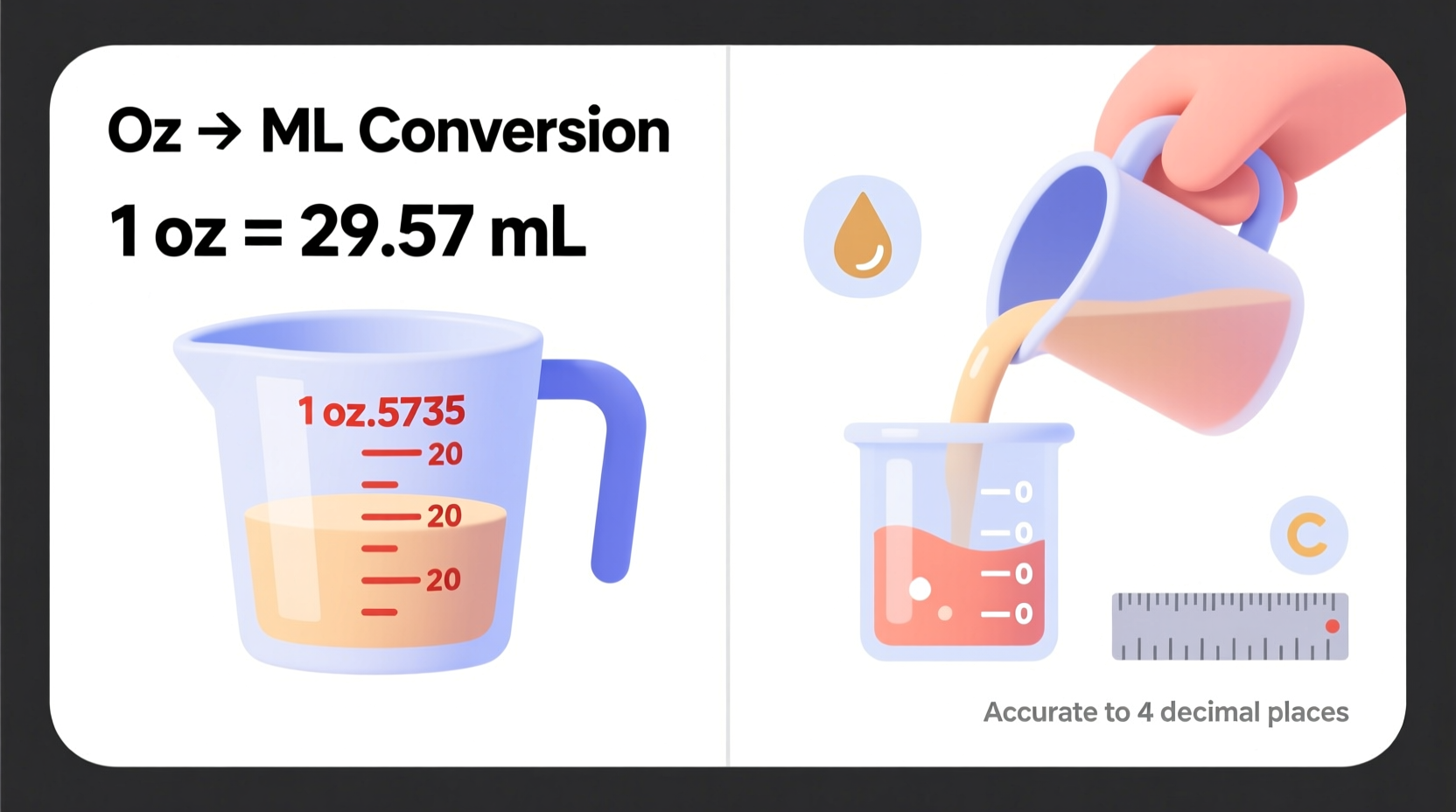Converting ounces (oz) to milliliters (ml) is a common task in cooking, baking, medicine, mixology, and international travel. Whether you're following a recipe from the U.S. that uses fluid ounces or reading a European label with milliliters, knowing how to convert between these units accurately ensures precision and consistency. While the process may seem technical at first, it’s actually straightforward once you understand the relationship between the two measurements. This guide provides reliable, easy-to-use methods so you can make conversions quickly and confidently—without relying solely on apps or online calculators.
Understanding Ounces and Milliliters

The ounce used in volume measurement is the fluid ounce (fl oz), not to be confused with the ounce used for weight. In the United States customary system, 1 fluid ounce equals approximately 29.5735 milliliters. The milliliter, part of the metric system, is widely used around the world and is equivalent to one-thousandth of a liter. Because most countries use the metric system, understanding how to convert fl oz to ml is essential for accuracy in global contexts.
It's important to note that there are two types of fluid ounces: US and UK (imperial). The US fluid ounce is smaller than the imperial fluid ounce used in the UK. For this guide, we focus on the US fluid ounce, which is more commonly referenced in recipes, nutrition labels, and consumer products.
“Precision in measurement starts with understanding the units involved. A small error in conversion can affect taste, texture, or dosage.” — Dr. Linda Ruiz, Food Science Researcher
Step-by-Step Conversion Using the Standard Formula
The most accurate way to convert fluid ounces to milliliters is by using the standard mathematical formula:
Milliliters = Fluid Ounces × 29.5735
This multiplier comes from the exact definition of a US fluid ounce in the metric system. Here’s how to apply it:
- Identify the number of fluid ounces you want to convert.
- Multiply that number by 29.5735.
- Round the result to a practical decimal place (usually one or two).
For example, to convert 8 fl oz to ml:
8 × 29.5735 = 236.588 ml → rounded to 236.6 ml
This method works for any quantity and is especially useful when dealing with non-standard amounts like 3.4 fl oz or 12.7 fl oz, where memorized equivalents won’t help.
Using a Conversion Table for Common Values
For everyday use, memorizing or referencing a conversion table saves time. Below is a practical reference chart for frequently encountered fluid ounce values:
| Fluid Ounces (fl oz) | Milliliters (ml) |
|---|---|
| 1 | 29.6 |
| 2 | 59.1 |
| 4 | 118.3 |
| 6 | 177.4 |
| 8 | 236.6 |
| 12 | 354.9 |
| 16 | 473.2 |
| 24 | 709.8 |
| 32 | 946.4 |
This table covers typical serving sizes, beverage containers, and recipe measurements. Print it and keep it on your fridge or save it to your phone for instant access.
Practical Tips for Accurate Conversions
While knowing the math helps, real-world application requires attention to detail. These tips ensure consistent accuracy:
- Always confirm whether the ounce refers to volume (fluid ounce) or weight—ingredients like honey or flour vary significantly.
- Use measuring tools marked in both units when possible, such as dual-scale liquid measuring cups.
- When cooking or baking, slight rounding (e.g., 30 ml per fl oz) is acceptable for small quantities but avoid cumulative rounding in large batches.
- Be cautious with medication dosages—always use calibrated syringes or droppers and consult healthcare professionals if unsure.
Mini Case Study: Baking Across Borders
Sophie, a home baker in Chicago, wanted to recreate a French cake recipe she found online. The recipe called for 150 ml of heavy cream. Since her measuring cup only had fluid ounce markings, she needed to convert ml back to oz.
She reversed the formula: Ounces = Milliliters ÷ 29.5735
150 ÷ 29.5735 ≈ 5.07 fl oz
Rounding to 5 fl oz, Sophie measured the cream accurately and achieved the right consistency in her batter. Her success came from understanding the bidirectional nature of conversion—not just oz to ml, but also ml to oz.
This example shows how even simple conversions empower better results in daily tasks, especially when working with international sources.
Checklist: Mastering Oz to Ml Conversions
Follow this checklist to ensure you’re converting correctly every time:
- ✅ Confirm you're using fluid ounces, not weight ounces.
- ✅ Use the multiplier 29.5735 for full accuracy.
- ✅ Round appropriately based on context (precision vs. approximation).
- ✅ Refer to a printed or digital conversion table for frequent values.
- ✅ Double-check medication or chemical measurements with a professional.
- ✅ Practice with common kitchen volumes until conversions become intuitive.
Frequently Asked Questions
Is 30 ml exactly equal to 1 fluid ounce?
No, 1 US fluid ounce is approximately 29.5735 ml, so 30 ml is a slight overestimate. However, for general purposes like cooking or hydration tracking, 30 ml per ounce is an acceptable rule of thumb.
Can I use the same conversion for all liquids?
Yes—the volume conversion from fl oz to ml is consistent regardless of the liquid type (water, oil, milk, etc.). However, weight-based conversions differ due to density variations.
What’s the difference between US and UK fluid ounces?
A US fluid ounce is about 29.57 ml, while a UK (imperial) fluid ounce is approximately 28.41 ml. Always verify which system a recipe or product label uses, especially in pharmaceuticals or imported goods.
Conclusion: Make Conversions Effortless and Accurate
Converting ounces to milliliters doesn’t require advanced tools or memorization. With a basic understanding of the conversion factor, access to a simple table, and a few smart habits, you can handle any measurement challenge—from scaling recipes to administering medicine. Accuracy builds confidence, and confidence leads to better outcomes in the kitchen, lab, or anywhere precise volume matters.









 浙公网安备
33010002000092号
浙公网安备
33010002000092号 浙B2-20120091-4
浙B2-20120091-4
Comments
No comments yet. Why don't you start the discussion?